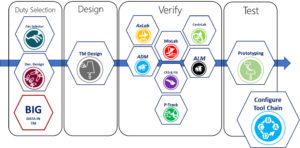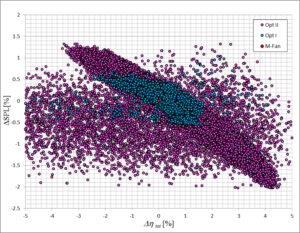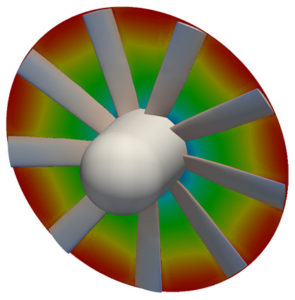Large diameter axial flow fans find application in forced or induced draft air-cooled condensers such as those used in CSP plants. These are large fans (external diameter 7m-10m) that are requested to process high flow rates operating at low pressure rise, and are usually characterized by high noise emissions. The role of the team for Industrial Turbomachinery at Sapienza University of Rome in the MinWaterCSP project is to apply noise reduction strategies to the design of a new-generation of axial fan for air-cooled condensers, working together with the aerodynamic team of Stellenbosch University, South Africa.
To this aim we are relying on a software suite developed in-house that allows for duty selection, design, verification and fast prototyping of turbomachinery, Figure 1.

Figure 1 – Sapienza in-house turbomachinery software suite
In particular the work is carried out with two major parallel activities, one based on:
- optimization of the aerodynamic design aiming at increasing efficiency and reducing trailing edge noise;
- identification of noise sources in the fan to apply passive noise and flow control strategies where needed
The first activity is carried out using the optimization tool of the turbomachinery suite. A preliminary sample of more than 400,000 fans was generated and tested with the Axlab fan performance prediction software in order to identify the individuals with the higher efficiency gain and lower sound power level, Figure 2.

Figure 2 – Performance of individuals selected through the optimization process

Figure 3 – Datum (left) and optimized (right) fan flow field
Fan performance are then verified with CFD computations, Figure 3.
The second activity, based on Computational Fluid Dynamics, aims at identifying the major noise sources to help understand what kind of passive flow control strategies to apply to the blade and later on to verify that these solutions do not interfere with the fan efficiency, Figure 4.


Figure 4 – Computed velocity field in the blade-to-blade passage for the fan
Author of this blog is: Allessandro Corsini, Spapienza University
About Sapienza University (project partner short name: UROME)
Sapienza University, founded in 1303 by Pope Boniface VIII in Rome, is one of the oldest universities in the world and a top performer in international university rankings.
The Faculty of Engineering aims at training young engineers with an advanced education, providing them with skills in designing, planning and managing complex activities of research and development in an industrial environment. This goal is achieved by means of a broad training proposal based on advanced mathematics and physics, and professional expertise targeted to the solution of complex engineering problems concerning design of processes, plants, systems, devices, machines.
The team for Industrial Turbomachinery of Dept. of Mechanical and Aerospace Engineering works on Research and Development of Innovative solutions for industrial turbomachinery design. We work on research of new numerical strategies for aerodynamics, heat transfer, erosion, fouling and fluid-structure interaction, design, optimization and verification software for turbomachinery and big data analysis applied to turbomachinery design and operations.





